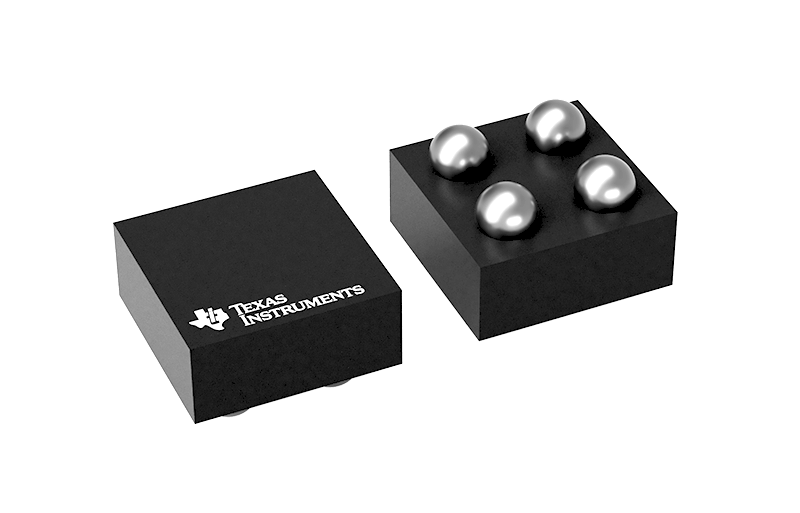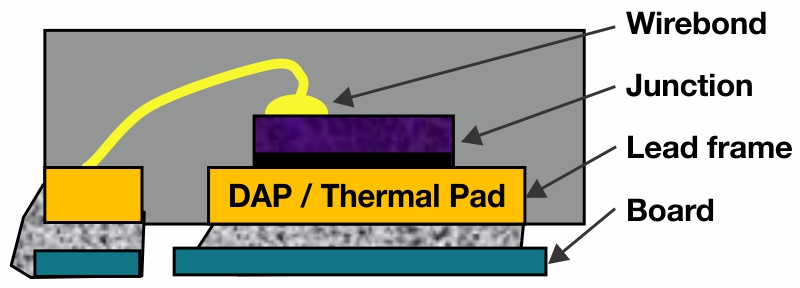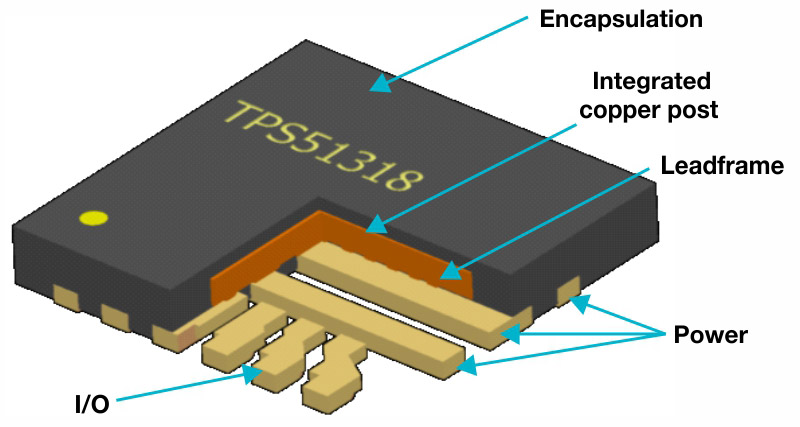SSZT096 february 2022 TPS22964C , TPS22975 , TPS22992 , TPS22998
From smartphones to cars, consumers are demanding more features packed into increasingly smaller products. To help with this trend, TI has optimized its packaging technology for our semiconductor devices, including the load switches used for subsystem control and power sequencing. Packaging innovation enables greater power density, making it possible to fit even more semiconductor devices and features onto each printed circuit board.
Wafer Chip-scale Packaging (WCSP)
Today, the smallest-size load switches available are in wafer chip-scale packaging (WCSP). Figure 1 shows an example of a four-pin WCSP device.
 Figure 1 Four-pin WCSP Device
Figure 1 Four-pin WCSP DeviceThe WCSP technique takes the silicon die and attaches solder balls to the bottom, giving it the smallest footprint possible and making the technology competitive in terms of current carrying and package area. Because WCSP minimizes form factor, the number of solder balls used for input and output pins limit the maximum current that the load switch can support.
Plastic Packaging with Wire-bond Technology
Higher-current applications or those with harsher manufacturing processes such as industrial PCs require the implementation of plastic packaging. Figure 2 shows a traditional plastic package implementation with wire-bond technology.
 Figure 2 Standard wire-bond quad-flat no lead (QFN) package
Figure 2 Standard wire-bond quad-flat no lead (QFN) packageQFN or small-outline no lead (SON) packages use wire-bond technology to connect the die to the leads, which enables higher amounts of current to pass from input to output while providing good thermal characteristics for self-heating. Wire-bond plastic packages need a lot of room for the bond wires themselves, however, necessitating a bigger package when compared to the die size itself. Bond wires also add resistance to the power path, increasing the total on-resistance of the load switch. Here, the trade-off is between a larger size and higher power support.
Plastic HotRod™ Package
While both WCSP and wire-bond packaging have their advantages and limitations, TI’s HotRod QFN load switches offer the advantages of both packaging technologies. Figure 3 shows a breakdown of a HotRod package.
 Figure 3 TI HotRod QFN Structure and Die Attachment
Figure 3 TI HotRod QFN Structure and Die AttachmentThese leadless plastic packages use copper pillars to connect the die to the package, and since this takes less area than bond wires, it becomes possible to minimize the package size. The pillars also support high current levels and add minimal resistance to the power path, allowing as much as 6 A of current through a single pin.
Table 1 illustrates these advantages through a comparison of the TPS22964C WCSP, TPS22975 wire-bond SON and TPS22992 load switches.
| Product and package type | TPS22964C WCSP | TPS22975 wire-bond SON | TPS22992 HotRod package |
|---|---|---|---|
| Input voltage | 1 V to 5.5 V | 0.6 V to 5.7 V | 0.1 V to 5.5 V |
| Current maximum | 3 A | 6 A | 6 A |
| On-resistance | 13 mΩ | 16 mΩ | 8.7 mΩ |
| Adjustable rise time | No | Yes | Yes |
| Power-good signal | No | No | Yes |
| Adjustable quick output discharge | No | No | Yes |
| Solution size | 1.26 mm2 | 4 mm2 | 1.56 mm2 |
While the TPS22975 wire-bond SON device can also support 6 A of current, achieving this current level requires two pins for both input and output voltages, which limits the number of additional features such as power good and adjustable rise time. The bond wires also add to the on-resistance of the device, limiting the maximum current.
The WCSP load switch is the smallest of the three solutions, but its limited pins give it the smallest number of features and the lowest current support.
Conclusion
The TPS22992 load switch combines the advantages of both WSCP and SON, offering the small-size advantage of the WCSP solution with the high current support and additional features of the wire-bond SON solution. TI’s TPS22992 and TPS22998 load switches use the HotRod package to optimize small solution size while supporting high current, low on-resistance and many device features.
Additional Resources
- Read the technical white paper, "When to Make the Switch to an Integrated Load Switch."
- Learn more about load switches in the application report, "Basics of Load Switches."
- Explore design tips in the ebook, "11 Ways to Protect Your Power Path."
- Read the application report, "Enhanced HotRod QFN Package: Achieving Low EMI Performance in Industry’s Smallest 4-A Converter."
- Check out TI’s QFN and WCSP packaging solutions.